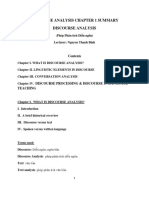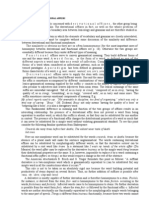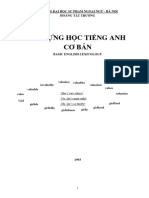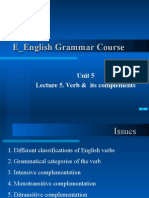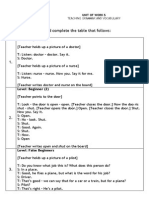Homonym in English - Vietnamese - Doan - Quynh - Nhu
Homonym in English - Vietnamese - Doan - Quynh - Nhu
Uploaded by
Hoàng MinhCopyright:
Available Formats
Homonym in English - Vietnamese - Doan - Quynh - Nhu
Homonym in English - Vietnamese - Doan - Quynh - Nhu
Uploaded by
Hoàng MinhOriginal Title
Copyright
Available Formats
Share this document
Did you find this document useful?
Is this content inappropriate?
Copyright:
Available Formats
Homonym in English - Vietnamese - Doan - Quynh - Nhu
Homonym in English - Vietnamese - Doan - Quynh - Nhu
Uploaded by
Hoàng MinhCopyright:
Available Formats
HO CHI MINH CITY UNIVERSITY OF EDUCATION
DEPARTMENT OF ENGLISH
HOMONYMY
IN ENGLISH - VIETNAMESE
Instructor : Nguyen Ngoc Vu
Student: Doan Quynh Nhu
Class: 4A
HCMC, 31/12/2010
D o a n | 2
Abstract
When speaking and listening, have you ever misunderstood or felt difficult in
choosing or understanding words? Of course, yes. What is the reason? From my point of
view, there are many reasons and one of them is confusing words because any language has
confusing words. This is the reason making us embarrassed because those confusing words
make us misinterpret someones meaning or be difficult to understand. Sometimes, there are
mistakes funny, otherwise, they are terrible. And homonym is one of the reasons causing this
phenomenon. I find it very interesting. Being an English teacher-to be, I want to search and
analyze the similarities and differences between English and Vietnamese homonym. This is
very useful for my teaching and I hope that I bring an exciting thing to you.
Literature review
What is homonym? The word "homonym" comes from the conjunction of the Greek:
prefix homo- (meaning same) and suffix -onym (meaning name). Thus, it refers to two or
more distinct words sharing the "same name". (Wikipedia) A homonym is one of a group of
words that share the same spelling or pronunciation (or both) but have different meanings.
The state of being a homonym is called homonymy. (English semantics) Examples of
homonyms:
In English, stalk which can mean either part of a plant or to follow someone around;
to, two and too are homonyms because they are pronounced the same, despite their spelling
differences.
In Vietnamese, ng (railway) ng tu Thng Nht; ng (sugar) mua mt cn
ng; sao (star) ng sao trn tri; sao (why) sao anh li lm nh th; sao (copy) i sao giy
khai sinh; sao (dehydrate) sao thuc nam.
D o a n | 3
In English and Vietnamese, homonym appears mainly between word-word. How
about between word-phrase, phrase-phrase? It is very rare. (C s ngn ng hc v ting Vit
188). For instance, the suns rays meet // the sons raise meat; or jack in the box // jack-in-the-
box.
However, they are also different because of the classification of homonym. Now, we
are going to have a deep look into the types of homonym in English and Vietnamese to see
how they are similar and different. Then we will find some various points between homonym
and polysemy. Finally, that is a summary about what we can learn and apply to our study and
teaching as well.
Homonym in English
Several similar linguistic concepts are related to homonymy. The term 'homonym' is
ambiguous because there are a number of ways that two meanings can share the 'same name'
and because the term is used in different ways by educated speakers, and these variant
meanings are recorded by dictionaries. The terms "homograph" and "homophone" are
however usually defined the same way as meaning "same spelling" and "same sound"
respectively.
The first, homonyms are words that have the same (sound and written) form but have
different meanings. For example, the noun bank
1
(a financial institution) and the noun bank
2
(the shore of a river), both being pronounced /bqk/ in RP. We will take bear for another
example: the noun bear, which refers to a large heavy animal with thick fur; the verb bear
1
,
D o a n | 4
which means give birth to, and the verb bear
2
, which means tolerate; all being pronounced
/beo/ in RP
1
.
The second, homographs are words that have the same written form but have different
meanings and sound forms. Example one: classified as two homographs are the verb lead
/li:d/ in Does this road lead to town and the noun lead /led/ in Lead is a heavy mental.
Another example: Classified as two homographs are the bare infinitive form read /ri:d/ and
the past tense form read /red/.
The third is homophones. Before giving definition of homophones, we will read this to
see what homophones are.
They dont look alike
theyre not spelled the same.
Thats how it is in the homophone game.
Homophones, homophones!
Can you find the homophones?
Oh, I went to the ocean to see the sea.
Homophones, homophones!
Last night a knight was looking at me.
Homophones, homophones!
Can you find the homophones?
1
Received Pronunciation (RP), also called the Queen's (or King's) English, Oxford English, or BBC
English, is the accent of Standard English in England, with a relationship to regional accents similar to
the relationship in other European languages between their standard varieties and their regional
forms.
D o a n | 5
We can realize that homophones are words that have the same sound form but have
different meanings and written forms. Such words include the noun hour (a twenty-fourth part
of a day and night) and the possessive adjective our (belonging to us), both being pronounce
/'auo/ in RP. Another two homophones are the noun place, which means a particular area or
position in space, and the noun plaice, which means a type of fish; both being pronounced
/pleis/ in RP. (See appendix for more examples)
Consider the following table and identify homonyms, homophones and homographs
via their main features. (English semantics)
Written form Sound form Meaning
Homonyms + + -
Homophones - + -
Homographs + - -
+: the same or nearly the same
-: different or opposite
Homonymy in Vietnamese
Vietnamese is a root-isolating language. On the other hand, this language is
uninflected. For this reason, those words are homonyms which always have the same spelling
and sound in any context. This is very different from English since it is an inflectional
language. Accordingly, these words are homonyms in this form but not in another form such
as verb meet (present form) and noun meat are homonyms, both have the same spelling /ni:I/
D o a n | 6
but verb met (past form of meet) and noun meat are not homonyms. Another example: the
noun saw (a tool that is used for cutting wood), noun sore (a painful, often red place on your
body where the skin is cut or infected) and verb saw (become conscious of something)-past
form of see are homonyms, these words are pronounced /so:/. As a result, Vietnamese
language classifies homonym in different way. There are two types of homonym: homonym
among words and homonym among words and syllables. Firstly, homonym among words has
two subclasses:
Lexical homonyms are those words belonging to the same word-class. Example like
ng
1
(road)-ng
2
(sugar), or ng knh
1
(a type of sugar)-ng knh
2
(diameter), they
are nouns. Another example: ct
1
ct nh (build a house)-ct
2
ct tin vo t (lay by ones
money in wardrobe)-ct
3
ct ru (distil spirit), they are verbs.
Another subclass is lexical-grammatical homonyms. That means those words are
homonyms belonging to different word-class. For instance, ch
1
cun ch (thread) (noun), ch
2
ch tay nm ngn (point) (verb), ch
3
ch cn c dm ng (only) (adverb).
This homonymic phenomenon is very interesting in Vietnam through proverbs and
word-plays like:
Bc
1
bc
2
trng. (bc
1
is a noun and bc
2
is a verb). Or
B gi ra ch Cu ng
Xem mt qu bi ly chng li
1
chng?
Thy bi gieo qu ni rng:
Li
2
th c li
3
nhng rng chng cn
D o a n | 7
At the first glance, maybe listeners will be angry. But when they realize these words
have the same sound but different meaning, listeners burst out laughing and are not angry.
Li
1
is an adjective which means useful; however, li
2
and li
3
are nouns which mean gums.
Secondly, homonyms among words and syllables are those words not belonging to the
same level of lexicon. For example Nh ca lm than con th tr ly ai rn cp the
syllable than (coal) and word lm than (complain) are homonyms; the syllable rn (forge) and
word rn cp (educate) are also homonyms. This phenomenon does not have in English
because Vietnamese language does not have the contrast between roots and affix; words are
formed by the combination of syllables.
Or only words also make us confused and funny like Ba qua
1
, qua
2
ni qua
3
qua
4
m qua
5
hng qua
6
. Hm nay, qua
7
hng ni qua
8
qua
9
m li qua
10
. Ba qua
1
means
yesterday; qua
2,
qua3, qua5, qua7, qua
8
means you and qua
4
, qua
6
, qua
9
, qua
10
means arrive.
These words are homonyms.
Distinguish between homonymy and polysemy
A well-known problem in semantics is how to decide whether we are dealing with a
single polysemous word (like plain) or with two or more homonyms (like port
1
, as in The ship
left port, and port
2
, as in He drank port). In other words, how do you know words are
homonyms or polysemy?
Some sources state that homonym meanings must be unrelated in origin (rather than
just different). Thus right (correct) and right (opposed to left) would be polysemous and not
be homonyms. Bank in river bank and Bank of England are homonymous: they share no
D o a n | 8
meaning whatsoever; they function as two totally unrelated words. River bed and hospital
bed seem to be somehow semantically linked: it is a case of polysemy.
Implications for language teaching
It is important to learn the different spellings, pronunciations and meanings of words
in the beginning stage of language learning or you could say something you dont mean or
understand something to be what it is not.
Homonyms are words like bank. All of these nouns are pronounced the same so you
really need to understand the context of the sentence or you wont know whether someone is
talking about a financial institution, or a shore of a river. The word sound is most often first
learned as noise. It is very basic vocabulary that all beginners know. But sound also means
something else as healthy. Examples like these are easier to spot in writing, since nouns
generally need an article in front of them, but in everyday speech if you cannot understand
every word and only catch certain basic vocabulary, you could completely misunderstand the
message. This is also why learning the pronunciation of conjugations of verbs is important at
the beginning stage. Obviously for words that are spelled the same, it easy to look up their
definition(s) and pronunciation(s) in the dictionary. But for words that are not spelled the
same, yet are pronounced the same, it can be a bit trickier.
Knowing more about homonymy, we can explore to know how to teach vocabulary
excitingly and also decrease difficulties for learners. Supposing we can make a sentence like
this Our bear cannot bear to be bare at any hour. And ask them to listen and repeat. Then
we will explain.
D o a n | 9
Conclusion
This phenomenon is very interesting and useful for our teaching and learners as well.
To us, we should explore many ways to help them study easier and find it exciting. In
addition, we also give them some tips to help them learn better. To learners, they should know
this and pay attention to pronunciation. Moreover, they should take notice of context when
they translate or listen.
D o a n | 10
Appendix
+ Heroin /'herouin/ (n) = (dc hc) thuc gy m lm t moocphin, dng trong ngnh dc
gy ng hoc gim au, hoc do ngi nghin ma ty dng; hrin
+ Heroine /'herouin/ (n) = n anh hung
Cite /sait/ (v) = trch dn
+ Site /sait/ (n) = a im, khu t ( xy dng).
+ Sight /sait/ (n) = khe ngm, tm ngm; quang cnh, cnh tng;
(v) = quan st, nhn thy
+Principal /'prinspl/ (n) = hiu trng (trng ph thng); (Adj) = chnh, ch yu.
+ Principle / 'prinspl/ (n) = nguyn tc, lut l
Hi (Cho) and High (trn cao, cao)
Hi, how are you? (Cho, bn c khe khng?)
At 12 o'clock the sun is high in the sky. (Vo 12 gi tra, mt tri ln cao.)
In (trong) v Inn (qun ru)
Come in and have a cup of tea. (Hy vo nh v dng mt ly tr.)
'Inn' is an old-fashioned word for 'pub'.('Inn' l t kiu xa ca t 'pub')
'' is an old-fashioned word for 'pub'.
New (mi) v knew ( bit)
I love your new dress! (Em thch chic o m mi ca ch.)
I knew the answer as soon as she asked the question. (Ti bit c cu tr li va khi c ta t cu hi.)
We (chng ti) v Wee (nh, b)
We (my husband and I) would love you to come and stay.(Chng ti (ng x ca ti v ti) mong mun bn n
chi v li.)
Scottish people say 'wee' for 'small' or 'little'. (Ngi Xct-len dng t 'wee' thay t 'small' hoc 'little'.)
Need (cn thit) v Knead (nho bt)
We're hungry so we need some food.(Chng ti i bng v th chng ti cn thc n.)
To make bread you have to knead the dough (a mixture of flour and water). ( lm bnh m, bn phi nho bt
nho.)
So (v th) v Sew (may v)
It's raining so you need to use your umbrella.(Tri ang ma v th bn cn s dng chic d.)
Will you sew a button on this shirt for me please? (Bn vui lng nh chic nt vo chic o ny cho ti nh?)
D o a n | 11
Reference
Ch, Mai Ngc, V c Nghiu, and Hong Trng Phin (1997). C s ngn ng hc v
ting Vit. Ho Chi Minh city: Education Publishing House.
Hin tng ng m. Truyencuoi
http://www.truyencuoi.vn/?menu=view_story&tl=108&truyen=289
Homonym. Wikipedia. Retrieved October 21, 2009
http://en.wikipedia.org/wiki/Homonym
Nhng cp t gy kh khn trong ting anh. Globaledu
http://www.globaledu.com.vn/Thong-Tin-Chi-Tiet/2712/Nhung-cap-tu-gay-kho-khan-trong-
tieng-Anh
Li chi ch trong i v th. nguoivienxu.vietnamnet.
http://nguoivienxu.vietnamnet.vn/chuyentiengmede/2004/03/54108/
Luyn ni ting anh. globaledu
http://www.globaledu.com.vn/Thong-Tin-Chi-Tiet/2225/2225
T Minh Thanh (2009) English Semantics. Ho Chi Minh City: National University.
You might also like
- Semantics Term PaperDocument14 pagesSemantics Term PaperNabaz MustafaNo ratings yet
- Homonymy in English - Vietnamese: Ho Chi Minh City University of Education Department of EnglishDocument11 pagesHomonymy in English - Vietnamese: Ho Chi Minh City University of Education Department of EnglishTran Anh DuyNo ratings yet
- Sense Relations IiDocument17 pagesSense Relations Iiatrocissimus leoNo ratings yet
- Unit 6B (2) : at Your ServiceDocument20 pagesUnit 6B (2) : at Your ServiceHuy Nguyễn Phan TrườngNo ratings yet
- RPH - BI Year 4 - 4 Seasons CovertDocument3 pagesRPH - BI Year 4 - 4 Seasons Covertsiraj27No ratings yet
- 4A07 LeThiThanhNhung Homonym in English and VietnameseDocument12 pages4A07 LeThiThanhNhung Homonym in English and VietnameseCristina MiaNo ratings yet
- 4A Ho Thanh An Functions of English Adjectives and Their Equivalents in Vietnamese LanguageDocument14 pages4A Ho Thanh An Functions of English Adjectives and Their Equivalents in Vietnamese LanguageTrúc Quỳnh TrịnhNo ratings yet
- Unit 5 Exercises, Problems, and Other Tasks:, E.G. ReadDocument4 pagesUnit 5 Exercises, Problems, and Other Tasks:, E.G. ReadIndahNo ratings yet
- từ vựng ngữ nghĩa ôn tậpDocument9 pagestừ vựng ngữ nghĩa ôn tậpdinhhuong2004.hnNo ratings yet
- HUBT Testing Center Test Code: 2: LexicologyDocument3 pagesHUBT Testing Center Test Code: 2: LexicologyPhương ThảoNo ratings yet
- Listening and Speaking Advanced c1 - Mid Term Test Ussh - 02-2021 Ielts - Speaking Topic ReservationDocument4 pagesListening and Speaking Advanced c1 - Mid Term Test Ussh - 02-2021 Ielts - Speaking Topic ReservationJosephM. Tài ĐứcNo ratings yet
- Intro 2 - Review Cuoi KyDocument2 pagesIntro 2 - Review Cuoi KyHà PhươngNo ratings yet
- W4 Synonymy Antonymy StudentsDocument15 pagesW4 Synonymy Antonymy StudentsTường Vũ ĐăngNo ratings yet
- 10 ĐIỂM HÌNH THÁI HỌCDocument5 pages10 ĐIỂM HÌNH THÁI HỌCLe HaoNo ratings yet
- 30 Câu SemanticsDocument16 pages30 Câu SemanticsTrâm LêNo ratings yet
- Đề Thi 20% Văn Học Anh Mỹ Số 2Document3 pagesĐề Thi 20% Văn Học Anh Mỹ Số 2Hữu Nghĩa Trần ĐỗNo ratings yet
- Intro To Linguistic 2 - Final Test ReviewDocument13 pagesIntro To Linguistic 2 - Final Test ReviewLãnh NguyệtNo ratings yet
- Test Fall2021 KEYSDocument4 pagesTest Fall2021 KEYSPhuong BuiNo ratings yet
- Luke Baldwin's Vow AnalysisDocument7 pagesLuke Baldwin's Vow AnalysisNguyễn Thị Ngọc DiễmNo ratings yet
- Discourse Analysis Chapter 1 Summary Discourse Analysis: (Phép Phân tích Diễn ngôn)Document13 pagesDiscourse Analysis Chapter 1 Summary Discourse Analysis: (Phép Phân tích Diễn ngôn)Rin EdmNo ratings yet
- Adjacencypairs WorksheetDocument4 pagesAdjacencypairs WorksheetgizmataNo ratings yet
- The Clothing That People Wear Affects The Way They Behave. (AGAINST)Document9 pagesThe Clothing That People Wear Affects The Way They Behave. (AGAINST)Ngô Hiểu NhiênNo ratings yet
- Nguyễn Thị Thúy Hiền - 19CNACLC08 - 411190553 - DNNAAV assignment CLCDocument7 pagesNguyễn Thị Thúy Hiền - 19CNACLC08 - 411190553 - DNNAAV assignment CLCThúy HiềnNo ratings yet
- NG Pháp CH C Năng KeysDocument11 pagesNG Pháp CH C Năng KeysGiang NguyễnNo ratings yet
- Giao Trinh Linguistics 1 - Unit 1Document7 pagesGiao Trinh Linguistics 1 - Unit 1Bảo Trâm100% (1)
- A Comparision of Verb Phrase Between English and Vietnamese (Final)Document27 pagesA Comparision of Verb Phrase Between English and Vietnamese (Final)Hoa Nguyen0% (2)
- (Ôn Research) - APA - Trích Các BTDocument9 pages(Ôn Research) - APA - Trích Các BThieuNo ratings yet
- TESTING and ASSESSMENTDocument40 pagesTESTING and ASSESSMENTbich vanthingocNo ratings yet
- I. Match The Following Paintings With Their Corresponding Names (0.75pt)Document4 pagesI. Match The Following Paintings With Their Corresponding Names (0.75pt)Linhtram LêNo ratings yet
- Derivational and Functional AffixesDocument7 pagesDerivational and Functional AffixesNicole PaladaNo ratings yet
- REVISION FOR PHONETICS & PHONOLOGY-OfflineDocument7 pagesREVISION FOR PHONETICS & PHONOLOGY-OfflineLê Thị Ngoan -DHNN14A3HNNo ratings yet
- Introduction To Linguistics-Group Work Assignments-T NG H p-30%Document9 pagesIntroduction To Linguistics-Group Work Assignments-T NG H p-30%tuanNo ratings yet
- Ngữ Nghĩa Đề 01 A Fill in each blank with One apropriateDocument7 pagesNgữ Nghĩa Đề 01 A Fill in each blank with One apropriateGiang TrầnNo ratings yet
- Negative Connotation: Stench Positive Connotation: AromaDocument2 pagesNegative Connotation: Stench Positive Connotation: AromaCherry Linh NguyenNo ratings yet
- Listening 2Document3 pagesListening 2DucNo ratings yet
- PPNCKH Loss and GainDocument24 pagesPPNCKH Loss and GainHạnh PhanNo ratings yet
- Assignment 13Document4 pagesAssignment 13Thảo ThanhNo ratings yet
- HUBT Testing Center Test Code: 1: LexicologyDocument3 pagesHUBT Testing Center Test Code: 1: LexicologyPhương ThảoNo ratings yet
- Phonetics Week 4Document3 pagesPhonetics Week 4Hải YếnNo ratings yet
- De Tieng Anh Tong HopDocument2 pagesDe Tieng Anh Tong HopTrân TrầnNo ratings yet
- A CROSS CULTURAL STUDY ON AMERICAN AND VIETNAMESE STUDENTS' BODY LANGUAGE IN ORAL PRESENTATION. Do Thanh Uyen. QH 06Document72 pagesA CROSS CULTURAL STUDY ON AMERICAN AND VIETNAMESE STUDENTS' BODY LANGUAGE IN ORAL PRESENTATION. Do Thanh Uyen. QH 06Kavic80% (5)
- Teacher: Trần Thị Thơ Class: Eng 319 Se: Syllabic ConsonantsDocument19 pagesTeacher: Trần Thị Thơ Class: Eng 319 Se: Syllabic ConsonantsNguyễn Hữu NguyênNo ratings yet
- Giáo trình - Từ vựng họcDocument60 pagesGiáo trình - Từ vựng họchuyentrangnna20No ratings yet
- 3rd Session CA 3Document4 pages3rd Session CA 3fNo ratings yet
- General Linguistics - Bùi Thị Mai Hoa - Homework 2Document8 pagesGeneral Linguistics - Bùi Thị Mai Hoa - Homework 2Thị Mai Hoa ĐàoNo ratings yet
- A Vietnamese - American Cross-Cultural Study of Conversational DistancesDocument53 pagesA Vietnamese - American Cross-Cultural Study of Conversational DistanceslehuulocNo ratings yet
- Bài Chữa Lớp Writing Online 8Document6 pagesBài Chữa Lớp Writing Online 8Vo Quang HuyNo ratings yet
- ĐA - Lexicology - 1104170 - 6-6-15Document4 pagesĐA - Lexicology - 1104170 - 6-6-15An HuynhNo ratings yet
- 4C06 LuuThiMaiVy Compound Words in English and VietnameseDocument22 pages4C06 LuuThiMaiVy Compound Words in English and VietnameseHứa Thị Thanh HàNo ratings yet
- Homework 3Document4 pagesHomework 3Uyên NguyễnNo ratings yet
- Đề Thi Từ Vựng - Ngữ Nghĩa Năm 2015Document4 pagesĐề Thi Từ Vựng - Ngữ Nghĩa Năm 2015Hoang RobinsonNo ratings yet
- Phraseology: Idioms and Proverbs: Unit 8Document15 pagesPhraseology: Idioms and Proverbs: Unit 8Khánh LyNo ratings yet
- Phonetics and Phonology - SampleDocument6 pagesPhonetics and Phonology - SampleNguyễn Trần Bá ToànNo ratings yet
- Cẩm NhungDocument7 pagesCẩm NhungNhân ĐNo ratings yet
- (ThichTiengAnh.Com) Giáo án Tiếng Anh lớp 10 cơ bản thí điểm đầy đủ UNIT (bản WORD)Document333 pages(ThichTiengAnh.Com) Giáo án Tiếng Anh lớp 10 cơ bản thí điểm đầy đủ UNIT (bản WORD)ĐTQ schoolNo ratings yet
- Improve Your Skills IELTS Answer KeyDocument32 pagesImprove Your Skills IELTS Answer KeyNgô Đức Hoàng Nhật0% (1)
- Ôn Thi GKDocument29 pagesÔn Thi GKNguyễn Trung TàiNo ratings yet
- MẪU LESSON PLAN UNIT 10- LỚP 11 - GLOBAL SUCCESSDocument40 pagesMẪU LESSON PLAN UNIT 10- LỚP 11 - GLOBAL SUCCESSHan NguyenNo ratings yet
- Review For The Final Test On The Introduction To Linguistics-70%Document14 pagesReview For The Final Test On The Introduction To Linguistics-70%tuanNo ratings yet
- File Tham Khảo Cho My 4Document19 pagesFile Tham Khảo Cho My 4Tran Anh DuyNo ratings yet
- Homonym yDocument6 pagesHomonym yDương Thảo LinhNo ratings yet
- ĐỀ TA Lớp 7 - Giữa Kì 1 Ma - de - 102Document2 pagesĐỀ TA Lớp 7 - Giữa Kì 1 Ma - de - 102Hoàng MinhNo ratings yet
- Giải Mã Đề Thi Vào Lớp 10Document38 pagesGiải Mã Đề Thi Vào Lớp 10Hoàng MinhNo ratings yet
- Formal Letter Expressions: SalutationDocument2 pagesFormal Letter Expressions: SalutationHoàng MinhNo ratings yet
- Passive VoiceDocument1 pagePassive VoiceHoàng Minh100% (3)
- For: VÌ And: Và Nor: Mà Cũng Không: Althoung, Though, Even Though + SVDocument2 pagesFor: VÌ And: Và Nor: Mà Cũng Không: Althoung, Though, Even Though + SVHoàng MinhNo ratings yet
- Writing A PEEL ParagraphDocument15 pagesWriting A PEEL ParagraphHoàng MinhNo ratings yet
- Grade 6 First Term Test-RevisionDocument24 pagesGrade 6 First Term Test-RevisionHoàng MinhNo ratings yet
- Let's Talk About SportDocument1 pageLet's Talk About SportHoàng Minh100% (1)
- Let's Talk About TravelDocument1 pageLet's Talk About TravelHoàng MinhNo ratings yet
- Regular and Irregular Plural NounsDocument2 pagesRegular and Irregular Plural NounsHoàng Minh100% (1)
- Consonant Sounds Vowel Sounds: Before BeforeDocument1 pageConsonant Sounds Vowel Sounds: Before BeforeHoàng MinhNo ratings yet
- Passive Voice in English and VietnameseDocument46 pagesPassive Voice in English and VietnameseHoàng MinhNo ratings yet
- Grade 9 First Term Tests - RevisionDocument36 pagesGrade 9 First Term Tests - RevisionHoàng MinhNo ratings yet
- Describing Places: Reading and Writing 1Document3 pagesDescribing Places: Reading and Writing 1Hoàng MinhNo ratings yet
- Grade 8 1ST Term Test-RevisionDocument26 pagesGrade 8 1ST Term Test-RevisionHoàng MinhNo ratings yet
- Let's Talk About FoodDocument1 pageLet's Talk About FoodHoàng MinhNo ratings yet
- Full Name: ..Class: Date: .Time: School Name .. .. IC.Document5 pagesFull Name: ..Class: Date: .Time: School Name .. .. IC.Hoàng MinhNo ratings yet
- Group 3 La Fix Pake BangetDocument34 pagesGroup 3 La Fix Pake BangetHanna FairussaniaNo ratings yet
- A Dictionary of Sanskrit GrammarDocument215 pagesA Dictionary of Sanskrit GrammarDr. Sashibhusan MishraNo ratings yet
- Azzedine Belhadj Middle School Time: 1H00 Teacher of English: Mr. RoaissatDocument2 pagesAzzedine Belhadj Middle School Time: 1H00 Teacher of English: Mr. RoaissatNesrine NounouNo ratings yet
- Week 5 Verb PhraseDocument91 pagesWeek 5 Verb Phraseadrianna990100% (2)
- Figure of SpeechDocument24 pagesFigure of SpeechGloryann MamacNo ratings yet
- ? Week 2 - Writing Task Assignment - My Daily RoutineDocument8 pages? Week 2 - Writing Task Assignment - My Daily RoutineFernando Esteban LlontopNo ratings yet
- English Grammar Analysis Understanding The BasicsDocument8 pagesEnglish Grammar Analysis Understanding The BasicsMohammad Alzein100% (1)
- 07-Unit 4Document13 pages07-Unit 4marta manzurNo ratings yet
- Appendix A - Self-Assessment Checklist Template - SITXHRM001Document4 pagesAppendix A - Self-Assessment Checklist Template - SITXHRM001great hubNo ratings yet
- (Ebooks PDF) Download Macedonian A Course For Beginning and Intermediate Students English and Macedonian Edition Christina E. Kramer Full ChaptersDocument84 pages(Ebooks PDF) Download Macedonian A Course For Beginning and Intermediate Students English and Macedonian Edition Christina E. Kramer Full Chaptersmoyersmarnie2100% (9)
- Chapter 3 Arguments and Non-ArgumentsDocument10 pagesChapter 3 Arguments and Non-ArgumentsSylvia Julia VojarNo ratings yet
- MORFOLOGIJADocument12 pagesMORFOLOGIJAEma Vučetić SavatićNo ratings yet
- Detailed LESSON PLAN NounsDocument6 pagesDetailed LESSON PLAN NounsMay Ann IgguaNo ratings yet
- Introduction To Linguistics (15 Weeks) VB2Document8 pagesIntroduction To Linguistics (15 Weeks) VB2ldthanhbinh.eNo ratings yet
- EASTE Module 2 - Unit 1, 2Document2 pagesEASTE Module 2 - Unit 1, 2Abida Pareveen50% (2)
- MPF in ContextDocument5 pagesMPF in ContextHenrique Moura100% (1)
- English 2010 ReflectionDocument2 pagesEnglish 2010 Reflectionapi-594904226No ratings yet
- Merifa Rahmawati ELTDocument1 pageMerifa Rahmawati ELTMerifaNo ratings yet
- Name of Group: 1. Djinggo Alhamra Jayanto 2. Huurein Fajar Fitriani 3. Intan Permata Putri 4. Popy Elponda NevilDocument9 pagesName of Group: 1. Djinggo Alhamra Jayanto 2. Huurein Fajar Fitriani 3. Intan Permata Putri 4. Popy Elponda NevilBiologiNo ratings yet
- Figurative LanguageDocument2 pagesFigurative Languagerashi 227No ratings yet
- Kel.1 BHS - Ing.komunikasiDocument8 pagesKel.1 BHS - Ing.komunikasiIsabel SabrinaNo ratings yet
- PART 1: Summary of The Entire Session: in EnglishDocument4 pagesPART 1: Summary of The Entire Session: in EnglishUmair AwanNo ratings yet
- Child Growth Chart PDFDocument1 pageChild Growth Chart PDFRana JaraysehNo ratings yet
- Teaching Speaking Skills 1 Teachingenglish British Council BBCDocument5 pagesTeaching Speaking Skills 1 Teachingenglish British Council BBCapi-538171971No ratings yet
- Els 109-Unit 2Document13 pagesEls 109-Unit 2taw realNo ratings yet
- Linguistic Relativity - A Study of The Role of L1 in L2 Vocabulary Acquisition in An EFL SettingDocument9 pagesLinguistic Relativity - A Study of The Role of L1 in L2 Vocabulary Acquisition in An EFL Settingdmri12196No ratings yet
- 9 Different Methods of Teaching The English Language in 2022 Updated Tefl Blogs - 62f1fd04Document14 pages9 Different Methods of Teaching The English Language in 2022 Updated Tefl Blogs - 62f1fd04Deon STNo ratings yet
- Indefinite and Definite ArticlesDocument7 pagesIndefinite and Definite ArticlesStephen MagudhaNo ratings yet
- Handout For Functional Grammar Course-UpdateDocument30 pagesHandout For Functional Grammar Course-Updatehamzahamrullah177No ratings yet



















